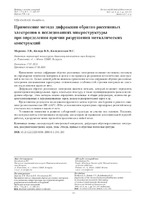| dc.contributor.author | Маркова, Л. В. | |
| dc.contributor.author | Коледа, В. В. | |
| dc.contributor.author | Колодинская, Н. С. | |
| dc.coverage.spatial | Минск | ru |
| dc.date.accessioned | 2018-09-18T09:05:21Z | |
| dc.date.available | 2018-09-18T09:05:21Z | |
| dc.date.issued | 2018 | |
| dc.identifier.citation | Маркова, Л. В. Применение метода дифракции обратно рассеянных электронов в исследованиях микроструктуры при определении причин разрушения металлических конструкций = Application of the electron backscateered diffraction method in microstructure research for determining of causes of metal structures destruction / Л. В. Маркова, В. В. Коледа, Н. С. Колодинская // Приборы и методы измерений : научно-технический журнал. - 2018. – Т. 9, № 3. – С. 243-253. | ru |
| dc.identifier.uri | https://rep.bntu.by/handle/data/47615 | |
| dc.description.abstract | Применение метода дифракции обратно рассеянных электронов позволяет по-новому взглянуть на структурные изменения материала в целом и на процессы разрушения металлических конструкций в частности. Целью данной работы являлось применение метода дифракции обратно рассеянных электронов для выявления характерных отличительных особенностей строения материала на участках под изломом и вдали от него. Дифракция обратно рассеянных электронов является методом, который позволяет определить ориентировки индивидуальных зерен, локальную текстуру, а также идентифицировать фазы в исследуемом образце. Этим методом можно определить локальные и общие деформации, количество рекристаллизованных и деформированных зерен, размер и разориентацию зерен и др. Представлены результаты исследования фрагмента мачты агрегата для бурения и ремонта скважин грузоподъемностью 200 т (АРС-200) с установлением характерных структурных различий между участками под изломом и вдали от него. Установлено появление и развитие субзеренной структуры на участке под изломом. Показано, что материал мачты изготавливался из проката, для которого не проводили дополнительной термообработки, и разрушение могло произойти практически в любой точке. | ru |
| dc.language.iso | ru | ru |
| dc.publisher | БНТУ | ru |
| dc.subject | Сканирующий электронный микроскоп | ru |
| dc.subject | Дифракция обратнорассеянных электронов | ru |
| dc.subject | Разориентация границ зерен | ru |
| dc.subject | Углы Эйлера | ru |
| dc.subject | Прямые и обратные полюсные фигуры | ru |
| dc.subject | Scanning electronic microscope | ru |
| dc.subject | Diffraction of backscattered electrons | ru |
| dc.subject | Differentiation of borders of grain | ru |
| dc.subject | Eyler’s corners | ru |
| dc.subject | Direct and reverse pole figures | ru |
| dc.title | Применение метода дифракции обратно рассеянных электронов в исследованиях микроструктуры при определении причин разрушения металлических конструкций | ru |
| dc.title.alternative | Application of the electron backscateered diffraction method in microstructure research for determining of causes of metal structures destruction | ru |
| dc.type | Article | ru |
| dc.identifier.doi | 10.21122/2220-9506-2018-9-3-243-253 | |
| local.description.annotation | The application of the diffraction method for backscattered electrons allows us to take a fresh look at the structural changes in the material as a whole and on the processes of destruction of metal structures in particular. The aim of this work was to apply the method of diffraction of backscattered electrons to reveal the characteristic distinctive features of the structure of the material in areas under the fracture and away from it. The diffraction of backscattered electrons is a method that allows one to determine the orientation of individual grains, the local texture, and also to identify the phases in the sample under research. This method can determine local and general deformations, the number of recrystallized and deformed grains, the size and misorientation of grains, etc. The results of a study of the mast fragment of the unit for drilling and repairing wells with a carrying capacity of 200 tons (APC-200) are presented with the establishment of characteristic structural differences between the sites under the fracture and away from it. The appearance and development of a subgrain structure at the site under the slope is established. It is shown that the material of the mast was made of rolled metal, for which no additional heat treatment was carried out, and destruction could occur at almost any point. | ru |

